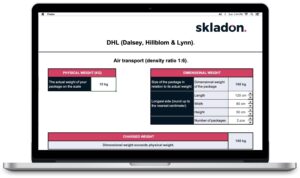Dimensional weight: How to calculate it and find out its price


The price for shipping depends on the final destination, size or weight of the shipment. Often, however, the weight of a package may not be based solely on the actual kilograms weighed; many carriers are also guided by the dimensional or volumetric weight.
What does this weight mean, how is it calculated and how does it vary across carriers? Read on in our article. As a bonus, we also offer you the option to download a calculator to calculate the dimensional weight.
What is dimensional weight
As the name implies, the dimensional weight refers to the amount of space that a given shipment occupies in the cargo area during transport. When pricing the transport of orders, it is therefore in some cases compared to the physical weight, i.e. the weight actually measured on the scale. The higher value is then taken into account to determine the final transport price.
Whether you handle logistics in-house or in cooperation with a fulfillment partner, you will sooner or later come across this pricing technique. It is commonly used by standard courier companies as well as by carriers specialising in oversized transport. Therefore, we recommend that you are familiar with it and understand it well enough to avoid being charged an incorrectly higher price for delivering products to the end user.
Pricing in parcel transport
Before 2015, local carriers and global shipping companies had a simple formula for calculating shipping costs. The physical weight of the package and the distance to the final destination played a role. It generally worked in direct proportion, i.e. the higher the weight or distance, the higher the cost.
Recently, however, a third variable has increasingly been included in the calculations: the size of the shipment. Especially in situations where light content is sent in bulky packaging. The shipment thus takes up valuable storage space – for this reason, carriers have decided to start taking the volume of shipments (or “package density”) into account as well.
The carrier then compares the physical and volumetric weight when setting the final price, always charging the higher weight. As a result, delivering a lighter package may cost you more than delivering a heavier package.
How to calculate the dimensional weight
The dimensional weight is calculated by multiplying the longest sides of the package by the carrier’s specific coefficient, which can vary significantly depending on the chosen mode of transport.
Calculating the dimensional weight step by step:
- Measure the length, width and height in centimeters of the shipping package. For packages with irregular, bulging or otherwise deformed shapes, the longest sides should be taken into account.
- Round the measured centimeters up to whole numbers.
- Multiply the measured values by each other to get the volume of the package.
- Divide the package volume by the carrier’s applicable coefficient for the specific mode of transport. This converts the package volume into kilograms.
Example: a cardboard box has dimensions 60 (L) * 40 (W) * 40 (H) cm. The coefficient for calculating the volumetric weight of a UPS carrier is 5,000 cm³ / kg. What is its dimensional weight?
- Package volume = (60 * 40 * 40) = 96,000 cm³
- Dimensional weight of the package = 96 000 / 5 000 = 19.2 kg
The bulk weight of a 60 x 40 x 40 cm package is 19.2 kg for UPS. If the physical weight of the package is less, you will be charged for the dimensional weight and vice versa.
Note: The 5,000 cm³ / kg coefficient used is used by most of the shipping companies in our portfolio. However, the value may vary depending on the choice of transport mode (air / sea / rail / road), the destination of the package or other specific conditions. For a complete interactive overview of the valid calculations of the most commonly used carriers, please refer to our calculator.
Note 2: In addition to dimensional weight, carriers also have dimensional and weight limits for packages as standard in their offer. If these limits are exceeded, the package cannot be shipped at a favourable weight.
Download the tool to calculate the dimensional weight across carriers
Are you looking for a tool to calculate the dimensional weight across carriers in one place? Download our dimensional weight calculator.
Find out which carriers we use, on which of their services, or at which destinations.
DOWNLOAD THE CALCULATOR HERE
Get a reliable fulfillment partner on your side
At Skladon, we work with 20+ local and global carriers. Thanks to our experience, we are able to select the ideal and most cost-effective service for your specific product, order volume, shipment size or destination. Take advantage of our low prices, which are achieved by accumulating our clients’ order volumes, or extended shipping time slots at later dates.
You will also find a wide range of shipping packaging in our distribution center, which allows us to adapt to ensure the lowest possible dimensional weight. We offer our clients 30+ sizes of cardboard boxes with various layering options, plastic bags, bubble or paper envelopes, book slits, paper bags, eco-equivalents and many more. Among other things, due to our strongly pro-customer and flexible approach, clients can choose between using our discounted or their own branded packaging material.
Focus on the core of your own business. Don’t worry about the logistics and entrust it to a fulfillment specialist.

